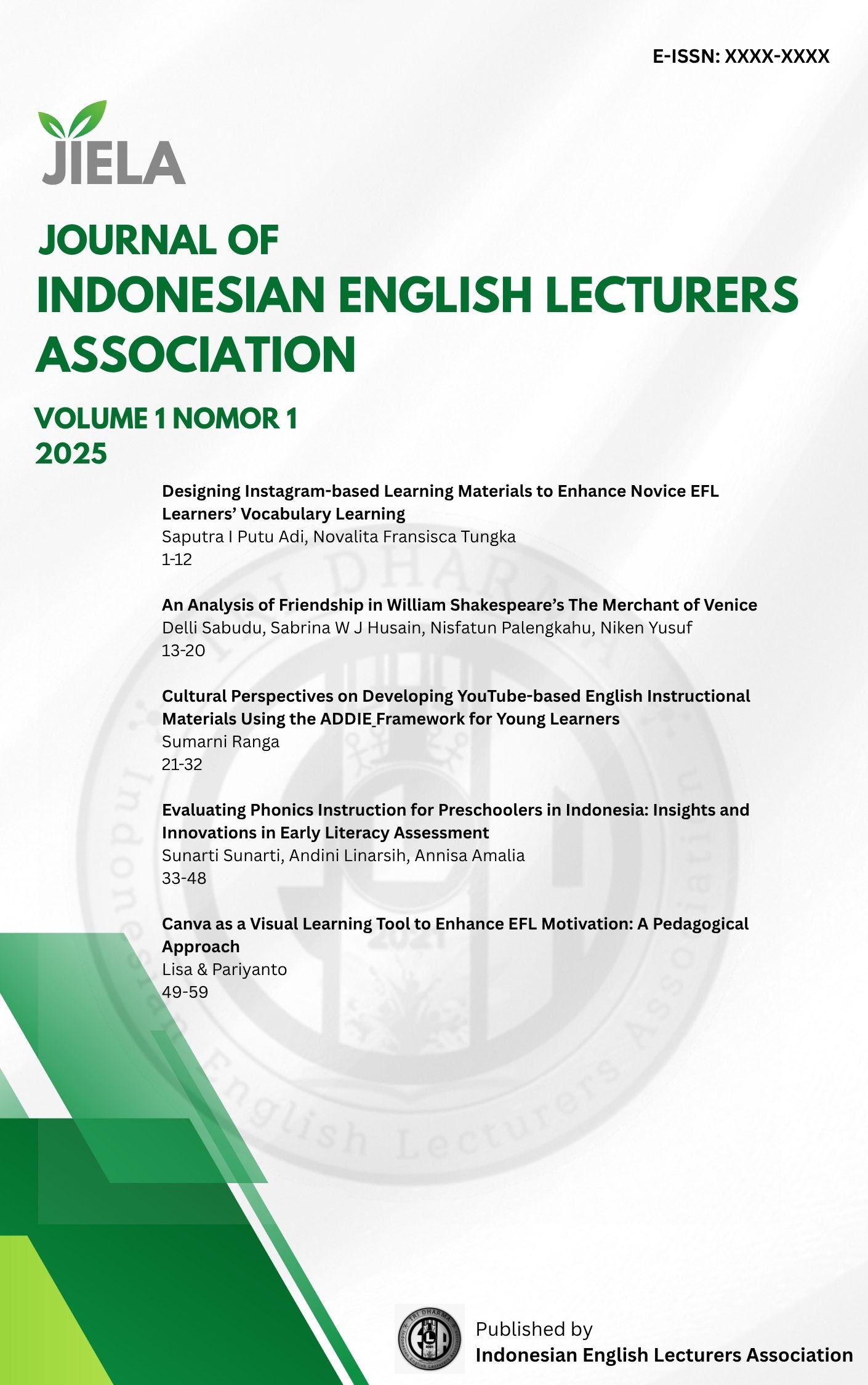Designing Instagram-based Learning Materials to Enhance Novice EFL Learners’ Vocabulary Learning
Keywords:
Instagram, Authentic materials, ADDIE, Vocabulary, Novice EFL learners, Instructional designAbstract
This study aims to present the process of designing Instagram-based learning materials aimed at enhancing English vocabulary learning among novice EFL learners in Masewe village. Using the ADDIE framework, culturally rich and authentic materials were designed to align with students’ needs, interests, and local contexts. The research revealed that integrating cultural and authentic elements into English learning materials can improve students’ motivation and engagement. Over a four-week implementation period, using tests and a questionnaire, participants demonstrated improvement in their English vocabulary and expressed increased motivation to learn English, particularly when authentic content was incorporated. This study highlights Instagram’s potential as an educational tool or media that fosters language learning through interactive and relatable experiences. Limitations of the study and topics for further research are also discussed in this article.
References
Alptekin, C. (1993). Target-language culture in EFL materials. 4712(April), 136–143. https://doi.org/10.1093/elt/47.2.136
Barfield, S. C., & Uzarski, J. (2008). Integrating indigenous cultures into English language teaching. English Teaching Forum, 47(1), 2–9. https://americanenglish.state.gov/files/ae/resource_files/09-47-1-b.pdf
Branch, R. M. (2010). Instructional design: The ADDIE approach. In Instructional Design: The ADDIE Approach. Springer US. https://doi.org/10.1007/978-0-387-09506-6
Chun, D., Kern, R., & Smith, B. (2016). Technology in Language Use, Language Teaching, and Language Learning. The Modern Language Journal, 100(S1), 64–80. https://doi.org/10.1111/modl.12302
Fauziah, N., Pebriano, N. A., & Murtiningsih, T. (2023). Analysis of vocabulary learning process from Instagram and TikTok. Jurnal Penelitian Ilmu-Ilmu Sosial, 4(1), 66–75. https://doi.org/https://doi.org/10.23917/sosial.v4i1.2367
Greaney, M., & Ellis, J. (2005). Using the ADDIE model for effective pedagogical interventions. http://www.vaniercollege.qc.ca/languageschool/Potatoes/home.htm]
Greenhow, C., & Lewin, C. (2016). Social media and education: reconceptualizing the boundaries of formal and informal learning. Learning, Media and Technology, 41(1), 6–30. https://doi.org/10.1080/17439884.2015.1064954
Gustafson, K. L., & Branch, R. M. (2002). Survey of Instructional Development Models. Fourth Edition. (4th ed.). ERIC Clearinghouse on Information & Technology.
Mahmud, M., Ammade, S., Halim, A., & Amin, F. H. (2022). Students’ Voices of the Use of Facebook and Instagram in teaching English in the university context. International Journal of Language Education, 6(2), 113–127. https://doi.org/10.26858/ijole.v6i2.24757
Molenda, M. (2015). In Search of the Elusive ADDIE Model. Performance Improvement, 54(2), 40–42. https://doi.org/10.1002/pfi.21461
Nasution, A. K. P. (2023). Instagram in English language learning: A systematic literature review. Journal of Linguistics, Literature and Language Teaching (JLLLT), 3(1), 33–52. https://doi.org/https://doi.org/10.37249/jlllt.v3i1.708
Peranginangin, S. A., Saragih, S., & Siagian, P. (2019). Development of Learning Materials through PBL with Karo Culture Context to Improve Students ’ Problem Solving Ability and Self-Efficacy. 14(2), 265–274. https://doi.org/10.29333/iejme/5713
Pujiati, H., Zahra, & Tamela, E. (2019). The use of Instagram to increase students’ motivation and students’ competence in learning English. Proceedings of the 1st International Conference on Education, Social Sciences and Humanities (ICESSHum 2019), 651–656. https://doi.org/10.2991/icesshum-19.2019.103
Saniei, A. (2012). Developing Cultural Awareness in Language Instructional Materials. 2012 International Conference on Language, Medias and Culture, 33, 10–15. https://www.academia.edu/download/76694244/003-ICLMC2012-L00008.pdf
Sanusi, A. P., Safitri, D. S., & Sabar, S. (2021). Instagram as media and tool in English language teaching. Palakka: Media and Islamic Communication, 2(1), 11–19. https://core.ac.uk/download/pdf/479104292.pdf
Sudiran, S. (2023). Indonesian Students’ Perception and Their Interpretation on Instagram as Media for Learning Reading Comprehension. https://doi.org/10.35629/7722-11124349
Syafruddin, A. B., Widarti, H. R., & Rokhim, D. A. (2024). Development of Instagram-based learning media to increase students learning interest in acid-base materials. Turkish Online Journal of Distance Education, 25(2), 228–247. https://doi.org/https://doi.org/10.17718/tojde.1312770
Tungka, N. F. (2012). Cultural Values as a Strategy of Using English in Japan. Jurnal Kependidikan, 5(1), 17–28. http://repository.unsimar.ac.id/id/eprint/1563
Tungka, N. F. (2017). Developing multimodal book for comprehension in multimodal literacy [Dissertation, Universitas Negeri Malang]. http://repository.um.ac.id/id/eprint/64433
Vierra, A. J., & Garrett, J. M. (2005). Understanding Interobserver Agreement: The Kappa Statistic. Family Medicine, 37(5), 360–363. https://web4.cs.columbia.edu/~julia/courses/CS6998/Interrater_agreement.Kappa_statistic.pdf
Downloads
Published
Issue
Section
License
Copyright (c) 2025 Journal of Indonesian English Lecturers Association (JIELA)

This work is licensed under a Creative Commons Attribution 4.0 International License.







